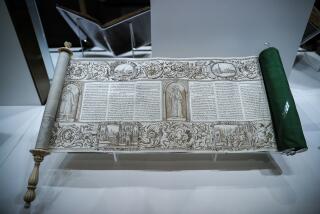The Feast of Lots (of Fun)
- Share via
JERUSALEM — There’s a certain feeling of joyous abandon in Israel at Purim, the happiest, most lighthearted holiday on the Jewish calendar, which begins Thursday evening. Tricks are permissible and treats essential. There’s a playful naughtiness unrestricted to age, sex or ethnic background. You might even call it the Jewish April Fool’s Day, with an entire country in cahoots.
One year, the national television station’s evening news was broadcast upside down, and the station’s solemn sign-off, the national anthem, was replaced by a rousing version of the Hallelujah Chorus from Handel’s “Messiah.” Another year a popular radio station announced that massive quantities of crude oil had been found under central Tel Aviv. And yet another year the Jerusalem Post published a fake front page.
Purim commemorates events occurring some 24 centuries ago in Persia. Persuaded by his evil advisor Haman to eliminate the entire Jewish population in his realm, King Ahasuerus drew lots (purim) to set the date for mass execution. His new young wife, Esther, who was renowned for her beauty (and who, unbeknownst to the king, was Jewish), learned of the dastardly plot from her uncle Mordechai and risked her life to outwit Haman and persuade the king to revoke the edict. In the end it was Haman who met his maker on that very same day-the 14th of the Hebrew month Adar-strung up on the gallows by the king. Generations after, Purim is still a joyous celebration of that escape from persecution.
For children, the holiday is also akin to Halloween, a dress-up time with costumes that once reflected the heroes of the Purim story and today include Pokemon characters, Ricky Martin and space aliens. Excitement begins weeks before the holiday, as youngsters plan their costumes and begin the process of daily persuasion to ensure that their parents will make or buy exactly the costume they want. Purim is a school holiday in Israel, and the streets are filled with children dressed up in costume finery, teenagers in silly outfits with painted hair and an occasional adult with rabbit ears. Carnivals, parties, masked balls, special performances for children, practical jokes, mishloah manot (gifts of food) and feasting are the order of the day.
In the evening, those who attend synagogue will hear the chanting of Megillat Esther, a scroll recounting the Purim story, and will help drown out Haman’s name with noisemakers every time it is mentioned. Long before the invention of cars, it was also considered a mitzvah or good deed to imbibe enough wine “so as not to be able to distinguish between the names of Haman and Mordechai.”
And yet, in recent years the advent of Purim also sends a twinge of fear through many parents, particularly in Tel Aviv. In 1996, a bomb exploded outside a crowded Tel Aviv shopping center on Purim, leaving 13 dead, including children in their Purim costumes. The next year, a suicide bomber blew himself up in a crowded Tel Aviv cafe, killing four women sitting with their children.
“Although the last few years have been quiet, I still take safety measures,” one mother said. “I won’t allow the kids to go on buses during the holiday, and we try to stay out of crowded public places.”
Though scores of ethnic groups exist in Israel, each with its own customs and concepts of holiday fare, certain culinary common denominators do exist.
The quintessential Purim delight is the three-cornered filled cookie (looking like George Washington’s hat) called hamantaschen in Yiddish and ozen haman in Hebrew. Developed by Eastern European Jews centuries ago, hamantaschen are made from either cookie dough or yeast dough and usually are stuffed with poppy seed or fruit fillings. They are variously considered symbolic of Haman’s pocket, Haman’s hat and Haman’s ear.
In Sephardic homes, grandmothers will also make orejas de Aman: crisp, deep-fried twists of dough dipped in sugar syrup or dusted with powdered sugar.
Poppy seeds have special significance during Purim, because tradition holds that Queen Esther chose a vegetarian diet of beans, nuts and various seeds, including poppy seeds, rather than eat non-kosher food in the king’s palace. Actually, it wasn’t such a bad idea, because poppy seeds are a good source of calories and calcium, zinc, manganese, copper, phosphorus, potassium and a wealth of B vitamins. Smart cookie.
Hamantaschen
Active Work and Total Preparation Time: 30 minutes * Total Preparation Time: 1 hour plus 2 hours chilling
Adapted from “The Jewish Holiday Cookbook” by Gloria Kaufer Greene.
FILLING
1/2 cup ground poppy seeds
1/4 cup milk, orange or apple juice
1/4 cup honey
1/4 cup raisins
1/2 tablespoon unsalted butter
1 teaspoon lemon juice
If ground poppy seeds are unavailable, grind them in a blender or coffee grinder. Place them in a small saucepan and add the milk, honey, raisins, butter and lemon juice. Cook over medium heat, stirring frequently, until most of the liquid is absorbed, 10 minutes. Remove the pan from the heat, cool the filling slightly, then cover and refrigerate it until firm, about 2 hours. (You can make this up to three days ahead).
ASSEMBLY
1/2 cup (1 stick) unsalted butter or margarine
1/4 cup light brown (or demerara) sugar, packed
1/4 cup honey
2 eggs
1 teaspoon vanilla extract
1 teaspoon baking powder
1/2 teaspoon baking soda
1 1/2 cups all-purpose flour
1 cup whole-wheat pastry flour
Filling
Cream the butter, brown sugar and honey in the bowl of a mixer on medium speed. Beat in the eggs, 1 at a time, and the vanilla, scraping down the sides occasionally.
Sift the baking powder, baking soda and all-purpose and whole-wheat flours together, discarding excess bran, if any, and blend into the butter mixture. Form the dough into two disk-like shapes and wrap them in plastic wrap or wax paper. Refrigerate the dough for several hours until firm. (This may be made up to three days ahead).
Heat the oven to 350 degrees.
Roll out 1 disk of the chilled dough on a lightly floured surface to 1/8 inch thick. Keep the other half in the refrigerator until ready to use. Use a large round cookie cutter, wide-mouthed glass or clean tuna can with the bottom removed to cut out circles. Place a teaspoon of the filling in the center of each circle and pinch the edges to form a triangle, leaving a small opening in the center to see the filling.
Place the cookies about 1 inch apart on a baking sheet lined with parchment paper. Bake them until the cookies are lightly browned, 12 to 14 minutes. Remove and co ol on a wire rack.
24 cookies. Each cookie: 146 calories; 58 mg sodium; 33 mg cholesterol; 5 grams fat; 3 grams saturated fat; 23 grams carbohydrates; 3 grams protein; 0.90 gram fiber.
Sliced Avocado With Poppy Seed Vinaigrette
Active Work and Total Preparation Time: 15 minutes
Sliced avocado in a sweet-and-sour vinaigrette tastes delicious as is, served on a bed of lettuce or mixed with other fruit, like sliced bananas, seedless grapes, star fruit or ripe pear.
1/4 cup honey or raw sugar
1/2 cup sunflower or safflower oil
5 1/2 tablespoons white wine vinegar
1 green onion, minced
1/2 teaspoon whole-grain Dijon mustard
Salt
2 teaspoons poppy seeds
4 large avocados, peeled and sliced lengthwise
Whip the honey, oil, vinegar, onion, mustard and salt to taste in a blender until emulsified. Stir in the poppy seeds.
Arrange the avocado slices on a serving platter and pour the dressing over.
6 servings. Each serving: 292 calories; 60 mg sodium; 0 cholesterol; 26 grams fat; 3 grams saturated fat; 16 grams carbohydrates; 1 gram protein; 2.67 grams fiber.
Poppy Seed Muffins
Active Work Time: 20 minutes * Total Preparation Time: 40 minutes
You can turn these into a cake by using a well-greased 9-inch square pan and baking about 40 minutes. Ice with chocolate frosting, if desired.
1 cup milk or soy milk
1/2 cup poppy seeds
1 cup (2 sticks) unsalted butter, at room temperature
1 cup white, raw or light brown sugar
3 eggs, separated
3/4 cup all-purpose flour
3/4 cup whole-wheat pastry flour
2 1/2 teaspoons baking powder
1/2 teaspoon salt
Heat the oven to 350 degrees. Line a muffin tin with paper baking cups.
Heat the milk in a small saucepan to just under boiling. Remove the pan from the heat and stir in the poppy seeds. Let the milk cool until it’s just warm.
Beat the butter with the sugar until light and fluffy. Beat in the egg yolks. Sift the all-purpose and whole-wheat flours with the baking powder and salt and add alternately with the milk and poppy seeds to the butter mixture, beginning and ending with the flour.
Beat the egg whites just until they’re stiff and gently fold them into the batter. Evenly divide the batter among the cups, filling them about 3/4 full. Bake the muffins until a toothpick inserted in the middle comes out clean, 25 minutes.
18 muffins. Each muffin: 212 calories; 149 mg sodium; 67 mg cholesterol; 13 grams fat; 21 grams carbohydrates; 4 grams protein; 1.14 grams fiber.
More to Read
Sign up for The Wild
We’ll help you find the best places to hike, bike and run, as well as the perfect silent spots for meditation and yoga.
You may occasionally receive promotional content from the Los Angeles Times.






